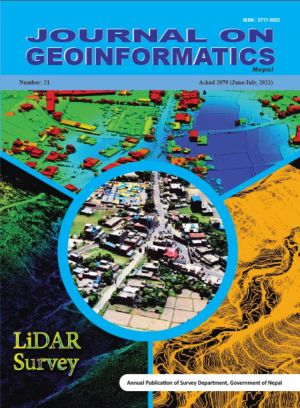Prospection of Potential Iron Deposit in Gandaki and Lumbini Province of Nepal Using Remote Sensing Technology
DOI:
https://doi.org/10.3126/njg.v21i1.50886Keywords:
Analytic Hierarchy Process (AHP), Suitability Analysis, Iron Deposit, Multi-Criteria Decision Analysis, Landsat-8, Principal Component Analysis (PCA), Remote Sensing (RS)Abstract
Integrated remote sensing and Geographic Information System provides an aid to find presence of metallic and non-metallic minerals. This approach was used to explore Iron deposits in districts of Gandaki and Lumbini province of Nepal in which 8 districts were identified as the reserves of iron ores namely Nawalpur, Palpa, Baglung, Parbat, Syangja, Tanahu, Arghakhanchi and Gulmi. These districts fall under various geological formation such as Suntar formation, Melpani formation. These formations are found to be rich in metallic minerals. Remote Sensing (RS) and Geographic Information Systems (GIS) offers a cost effective and attractive strategy in mineral prospection, notably for a mineral exploration project. Landsat 8 satellite images, processed through band rationing method highlights the hydrothermal alterations and Iron Oxide containing region. False Color Composite and Principal Component Analysis method highlights sedimentary rocks. Each method exaggerates spectral signatures which highlights the surfaces by different colors indicating presence of iron ores. Lineaments are also extracted from Landsat images combining with Digital Elevation Model (DEM).
Lineaments are those structures that provide information about fault and fractures on the surface and helps to identify mineral deposition zones. The result produced through different RS techniques were introduced in GIS environment. Potential iron content region were identified by using Suitability analysis i.e. multi criteria decision analysis (MCDA). Map showing the potential iron ore deposit map was generated by integrating the results together reclassified into a common scale and overlaid with suitable weightage. Final output/map indicates the best possible sites for detailed study of iron ores. The study demonstrates the usefulness and effectiveness of remote sensing and GIS in iron and other mineral mapping.




